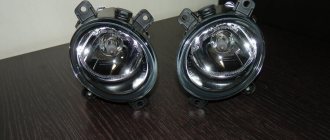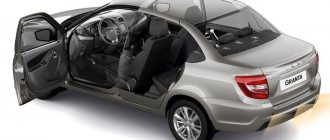Lada Granta Liftback has become a successful combination of accessibility and comfort.
Since the development of the very idea of the car began in 2008, during the global crisis, affordability was among the priorities, which in no way should affect safety and performance characteristics. Although the development and creation of the car took a long time, the result requires discussion.
Body evolution
When looking at the work of the designers, the first thing that catches your eye is the unusual shape of the rear of the car. The body of the Granta has undergone changes in comparison with the classic Lada Granta, while the designers paid great attention to seemingly insignificant details, which indicate a number of design improvements.
The features of the Grant Liftback trunk are as follows:
- The body project was created jointly with engineers working for Renault and Nissan, using computer modeling.
- During the creation of the body, a full-fledged rear door appeared in place of the trunk.
- Increasing the rigidity of the structure in comparison with the basic Granta model contributes to strength. The Granta trunk trim is completely galvanized, and those parts and hidden elements that were quite often subject to corrosion in early models are now covered with finishing primer.
- The fifth door of the car, located in the rear of the body, greatly simplifies loading things and increases the volume of the trunk.
Link by topic:
Tuning Grants Liftback
Users note that the design of the roof has changed due to the greater capacity of the body; the roof in the rear of the cabin has also been reduced.
Plans
In the near future, we should expect the appearance of facelift modifications, first of all, we are talking about the station wagon and its pseudo-off-road version Cross (its mass production is planned for the first half of 2022). There should also be a sports version called Sport (factory workers are talking about this modification - we are working on it, but no one has seen it in 2022).
The plant plans to produce this restyled Lada Granta FL until 2021-2023. And then they think about producing a second generation. Work on it is underway, Vasily Batishchev, the same one who was responsible for the first generation, has been appointed chief engineer. The project manager is Olga Bazhanova, who at one time was involved in the Lada Priora family. It is known that the second generation will be built on a French trolley, a modernized Global Access platform. PJSC AvtoVAZ has lost its independence. The French said not to invent anything themselves anymore and that’s it. But there were glorious times before. Only Vesta, Niva (the second generation is already on the French car), and Granta remained on their original platform. There were attempts to do something. They tried to integrate the front part of the S platform into the good old Gamma platform. Cheap, cheerful, but it didn’t work out; the French owners are against it. Unification now rules the world.
If you decide to buy a Lada Granta in Kazan and need spare parts or repairs or maintenance, please contact our car portal.
MAINTENANCE REGULATIONS FOR LADA GRANTA
Exterior design Grants Liftback
The appearance of the car is quite simple and unpretentious. Quite simple design solutions were taken from the design of the classic Granta, which many users did not like.
Since the project was developed over a long period of time, the design simply became outdated. However, if you make allowance for the budget of the car itself, then appearance is clearly not a priority.
Car interior design
In contrast to the design of the Liftback's external components, more meticulous work has definitely been done on the interior. If we draw parallels with Kalina, then the Liftback salon has an organization aimed at expanding the internal space.
The dashboard and other technological components are not very detailed and are made in a more standard form. This also had a positive effect on the cost of the car, which made it so affordable.
Chassis and features of its use
Although the suspension on the Lada Grant Liftback does not introduce anything new, since it was largely borrowed from the Kalina model, its modifications had a positive effect on the technical characteristics of the car.
This is especially noticeable for the Luxury configuration, in which the stabilizers responsible for the stability of the car in the transverse plane have become much more powerful, which directly affects maintaining the position of the car during sharp turns.
Gas-filled rear shock absorbers were also installed, along with stiffer springs. The introduced innovations are designed to make the car more stable when driving and making sharp turns, taking into account the typical road terrain.
History of creation
The history of Lada Granta begins in 2008. Then the need for a new model had already become critical, and given the crisis, it had to be inexpensive, but of high quality. Then it was decided to develop a new model based on the Lada Kalina. The first sketch was ready by the spring of 2009, and already in May of the same year the project for the production of Lada Granta was launched.
The designers spent two and a half years creating the new model. The speed of creation was facilitated by the fact that Kalina’s platform was already in digital form at that time.
In order for the car to have its own design, different from the original Lada Kalina, a competition was announced among the company's designers. Ivan Lepeshkin won, so they began to create the style of the new Lada based on his sketches. The design is based on a transverse bar on the radiator, on which is the Lada brand emblem. A boat is used as an emblem, and the chrome line symbolizes the Volga.
The first tests of the new model on the road confirmed the reliability and safety of the car. The design is ideal for Russian roads. The spaciousness of the Lada Grant is also unrivaled. Its advantages also include high ground clearance, a long body base and a minimum of overhangs.
Gearbox and its problems
The first version of the manual transmission in the Lada Grant Liftback was a partially modified manual transmission from Kalina. All those problems noticed by users on the previous model remained unresolved.
Related link:
Installation of air conditioner Lada Granta Liftback. Reviews. Price
Features such as excessively large travel of the gear shift lever and the need for effort were noted. Taking into account the complaints of motorists, engineers carried out a number of modifications, and subsequently all new cars of this model began to be equipped with a new version of the manual transmission.
One of the main innovations of the manual transmission was the cable drive. This made it possible to increase the smoothness of operation and significantly reduce vibration of the box during operation, which was also repeatedly noted by users. The first and second gears received updated synchronizers, which improved the service life of the entire system as a whole. Modifying the box also made it possible to significantly reduce oil consumption.
Lada Kalina
In the mid-90s, the development of a new generation of subcompact cars began, which would later be called the Lada Kalina family. There may be discrepancies with dates. On the one hand, to develop a new model, what was left of the A93 project, the same Elabuga small car, was used. On the other hand, within the framework of the People's Car project, known as VAZ 1116, there were certain developments. Let's not touch on this topic. Although the story then turned out not to be very good.
Initially, work was carried out on a hatchback, which then received the VAZ 1119 index, let’s say - since 1993. In 1998, they decided on the name Lada Kalina (although initially it was still Calina) and although this is a working name, the car was always called Lada Kalina in Russian. In 1999, a prototype of a five-door hatchback was ready. In 2000, there was already a working prototype of a four-door sedan. And in 2001, a station wagon was also assembled. But it will take another 3 years before the car goes into production; there was simply no money for mass production. Also in 2001, the second generation Lada Niva was sold to Americans for this reason. Americans are still happy that they received a pre-production car for pennies and launched it into series at minimal cost, calling it Chevrolet Niva. But that's a completely different story.
On November 18, 2004, the model was launched into production, its production continued until March 1, 2013. In terms of body types, initially it was on November 18, 2004 that a four-door sedan (VAZ index 1118) went into production. Two years later, on July 21, 2006, they began to assemble a five-door hatchback (VAZ index 1119). And in July 2007, production of a five-door station wagon began (VAZ index 1117). It was on the basis of this model that the development of a new family, the Lada Granta line, began.
The fate of the sedan is the most difficult. It was initially discontinued in March 2009. Production then resumed in September 2009 and was finally completed on May 1, 2011. To replace it, the new Lada Granta has been developed, also known as the VAZ 2190 in the body of a four-door sedan.
The next year, in August 2012, the second generation Lada Kalina was shown at the international motor show in Moscow. In 2013, namely on May 16, 2013, production of the five-door hatchback (VAZ index 2192) and station wagon (VAZ index 2194) started. This time the situation was played out in a different direction. If the Lada Granta is built mostly on the basis of the first generation Lada Kalina, then the second generation Lada Kalina 2 is created on the basis of the four-door Lada Granta sedan (VAZ index 2190). The differences from its predecessors are in the exterior, significant in the interior and technical parts. Let's note the presence of new engines (this, of course, is said loudly, all VAZ power units are connected by one thin strong thread), a four-speed Jatco automatic appeared in the transmission and work was done on the suspension, but the rear suspension turned out to have negative camber. The manual transmission is also modernized, an Atsumitec cable drive was installed, as well as a Shaeffler gear selection mechanism. They began to use a new, so-called “short” steering rack.
The stern has been changed on the exterior, and the interior has a new center console.
Based on the station wagon and hatchback, their own modifications were created. In the summer of 2014, the hatchback received the sports modification Lada Kalina Sport, and the station wagon received the pseudo-off-road Lada Kalina Cross.
And this situation with the Lada Kalina 2 family continued until 2018. They lost one fighter, we are talking about a four-door sedan, the rest were produced until the next facelift. In 2022, AvtoVAZ PJSC decided to curtail the assembly of cars of the Lada Kalina 2 line. That is, production did not stop. In fact, the hatchback and station wagon received a new name. Now this is the Lada Granta hatchback (the internal designation remains the same - VAZ 2192) and the Lada Granta station wagon (also unchanged - VAZ 2194, respectively).
Lada Granta Liftback Automatic: equipment and functionality
A positive quality of the automatic transmission is the ability to accelerate from 0 to 100 km/h in just 11 seconds. If after some time a manual transmission begins to make noise that creates discomfort, then this does not happen with an automatic transmission; all actions are silent.
The Japanese company Jatco worked on the automatic transmission. Adjusting the compatibility of Japanese and domestic technologies into a single functional unit required thirty attempts and the involvement of Austrian designers. Such attention to detail made it possible to create a user-friendly automatic transmission without visible flaws.
Particular attention was paid to the ergonomics of the gear knob. It is at the optimal height level and fits well in the hand. The first and second gears are fixed, and there is also a button on the selector that deactivates the overdrive mode, preventing access to shifting to fourth gear.
Power unit: main features
The basic configuration of the Lada Granta Liftback is equipped with a four-cylinder engine with eight valves, the volume of which is 1.6 liters. The engine power is 87 horsepower and the rpm is at 5100.
With this functionality, the engine is also quite economical; for 100 kilometers it will need only seven liters of gasoline.
Related link:
Lada Vesta or Lada Granta Liftback? Expert opinion
In the first configurations, a power unit was installed on the car model, which was fully synchronized with a four-speed automatic transmission, which was equipped with some cars.
Sports modification
If the hybrid version hasn’t worked out yet, then it’s quite possible to buy a Lada Granta with a sports modification. In 2011, it was presented to the public as part of the promotion of the Lada Granta as a new car from the Togliatti automaker. True, it was a combat racing car, and not a production version. It was used to participate in road racing. But already in 2012 in Moscow, at the international automobile show, a serial sports modification was demonstrated. It was called Lada Granta Sport (in Russian Lada Granta Sport). The development was carried out by a subsidiary of Lada Motor Sport Technologies. By the end of the year, small-scale production of the car was established. How is this modification different? It has a white and red “Sport” inscription printed on the trunk lid, a different shape of the front and rear bumpers (they have become more voluminous), and sills. A rear wing is installed on the trunk lid. Plus a different shape of sixteen-inch wheels. The model turned out to be dynamic.
A seven-inch display of a multimedia system with touch-type control has appeared in the cabin. The manual transmission lever and steering wheel are trimmed in leather with red stitching. The shape of the front driver and passenger seats has been changed. First of all, their lateral support has been significantly improved.
Plus, this model was produced in a luxury configuration, which means with full power accessories, air conditioning, two front airbags and an on-board computer, heated windshield and rear windows.
On the technical side. The gearbox was a five-speed manual. The chassis layout remained unchanged, but the suspension was slightly modified and the settings were changed. Larger brake discs were installed in the front brake mechanisms, and discs of a smaller diameter were used at the rear rather than drums. The tires were low-profile on 16-inch wheels, usually Yokohama. We also note the very short steering rack of 2.7 turns. There were two engines, both petrol naturally aspirated sixteen-valve overhead (DOHC) fours with a volume of 1596 cm³, one VAZ 21126, the other was installed from November 2016 to July 2022 only for the Drive Active package, this is the VAZ 21127 engine.
Correlation between Grants Liftback trim levels and price categories
The configurations differ from each other not only in interior design, but also in technological aspects, such as engine, transmission and tank volume.
Knowing these parameters allows for a more informed choice.
| Equipment | Volume of the tank | Engine | Transmission | Price | |||
| Standard | 1.6 liters | 8 valves (87 horsepower) | 5MT | 394,900 rubles | |||
| Classic | 1.6 liters | 8 valves (87 horsepower) | 5MT | 420,600 rubles | |||
| Classic Start | 1.6 liters | 8 valves (87 horsepower) | 5MT | 442,700 rubles | |||
| Comfort | 1.6 liters | 8 valves (87 horsepower) | 5MT | 459,200 rubles | |||
| Comfort Optima | 1.6 liters | 16 valves (106 horsepower) | 5MT | 475,100 rubles | |||
| Lux | 1.6 liters | 8 valves (87 horsepower) | 5MT | 497,200 rubles | |||
| Luxury Prestige | 1.6 liters | 16 valves (106 horsepower) | 5MT | 527,700 rubles | |||
| Comfort | 1.6 liters | 16 valves (98 horsepower) | 4AT | 523,100 rubles | |||
| Lux | 1.6 liters | 16 valves (106 horsepower) | 5AMT | 533,700 rubles | |||
Contents
The Lada Granta is cons >[8]
| Standard | Normal | Luxe | |
| Body style | 4-door sedan | ||
| Passengers | 5 | ||
| Length, mm | 4 260 | ||
| Width, mm | 1 700 | ||
| Height, mm | 1 500 | ||
| Wheelbase, mm | 2 476 | ||
| Curb weight, kg | 1 040 | 1 080 | 1 100 |
| Full weight, mm | 1515 | 1555 | 1575 |
| Max speed, km/h | 178 | 188 | 192 (Manual) / 187 (Auto) |
Safety Edit
The Granta was tested by ARCAP in 2012, earning two stars out of four. The test vehicle had a Takata airbag for the driver, but none for the passenger. The head injury criterion was 522 for the driver and 880 for the passenger. [9]
The Granta Lux earned three stars out of four and 10.5 points out of 16 in a crash test conducted in 2015 by ARCAP. The HIC was 590 for the driver and 428 for the passenger, whereas the compression of the thoracic cavity was measured as 28 mm and 25 mm, respectively. The car was tested with two airbags and seat belt pretensioners. [10]
Trim levels Edit
The car comes in three different trim levels: Standard, Norm and Lux. The Norm level includes power steering, front power windows, power door locks and trip computer, while Lux adds passenger airbag, side airbags, ABS, ESC, rear power windows, air conditioning, heated mirrors, heated front seats, and multimedia system with a 7-inch touchscreen display.
Marketing Edit
The Lada Granta is marketed in Russia, Belarus, Ukraine, Armenia and Azerbaijan, and within the European Union, it has been made available in the Czech Republic, Slovakia, Austria, Hungary, [11] France, Germany and Egypt. [12]
Safety Grants Liftback on the roads
Driver safety is ensured by the length and reinforced walls of the hood. The wipers have thin pads, and numerous crash tests have shown that this also has a direct impact on driving safety.
The airbag was developed jointly with engineers from Japan and Germany, and the seat belts were also modernized. In the rear of the car, the rigidity of the floor has been increased. To increase safety parameters, additional stiffening ribs were added, and the metal itself became much thicker.
The following elements were used as structural safety measures for the driver and passengers:
- a system that prevents slipping on uneven sections of the road;
- passenger and driver airbags;
- head restraints located on the rear seats;
- front seat belts with a pretensioning device;
- All doors are equipped with safety bars, as a result of which they will not be blocked.
Related link:
Test drive Grants Liftback
Crash tests showed extremely optimistic results, indicating that special attention was paid to driver safety.
The airbag is placed in such a way as to minimize driver injuries in the event of an accident, and the windshield breaks with fragments outward, as a result of which those present in the car will not be harmed.
History of the name
Initially, the project (the car's internal designation was VAZ-2190) had the working title “Low cost ”
). The name for the car was chosen from several thousand options sent as part of the “People's car - a people's name” competition announced by AvtoVAZ. The winner of the competition was a resident of Krasnoyarsk, Pavel Zakharov, and the Lada Kalina was solemnly presented as a reward to the author of the name Lada Granta during the 2010 Moscow Motor Show [1].
Features of using the transmission
The engine is synchronized with a manual gearbox, due to which it accelerates to 100 km/h in 12 seconds. And if the power unit has 106 horsepower, the acceleration time to 100 is reduced to 10 seconds.
The maximum speed with such characteristics is at around 179 kilometers per hour. A five-speed manual transmission, also known as a “robot,” improves acceleration without affecting gas consumption or speed.
Specifications
Refinement of the sedan allowed the designers to take the technological components of the Grant to a new level.
Characteristics of Lada Granta Liftback:
- Accelerates from 0 to 100 km/h in just 10 seconds. The maximum travel speed is also at a high level and for the Lada Granta 8-valve engine it is 166 km/h.
- Fuel consumption for a car under normal conditions is 6-7 liters per 100 kilometers.
- On uneven road surfaces or in off-road conditions, it has excellent cross-country ability thanks to updated suspensions.
- Enlarged luggage compartment (from 440 to 760 liters) with a convenient design that allows you to store things comfortably.











